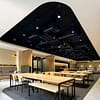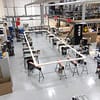Blog
LED Linear Office Lighting – A Guide
What is LED Linear Lighting?
LED Linear lighting office lighting has swiftly become the most popular and trendy solution for lighting modern commercial spaces, as it is a simple yet highly effective concept that is aesthetically attractive as well as very energy efficient. LED Linear Lighting essentially consists of a few key elements. Firstly, the housing, is the aluminium profile in which the other elements of the light sit. This is made from aluminium mined from an element called bauxite, which once extracted is molten and extruded through a mould to form the correct profile size and shape. Synergy’s quality assurance at this stage is critical – the profile must be perfect to create the finished fitting of the high standard that Synergy’s clients insist on. This housing this then powder coated to the finished colour – this can be standard or a bespoke RAL colour of your choice.
Inside this aluminium housing is then inserted the heat sink, which dissipates the small amount of heat generated by the LEDs, the LED board which holds the diodes themselves, and the driver unit – this regulates the flow of power to the LEDs and where applicable allows for dimming capabilities (see the section on dimming later in the article). Last, but not least, the diffuser; this is the plastic cover that clips into the open face of the profile and diffuses the light emitted from the diodes. A diffuser gives LED linear the effect of a solid line of light, instead of the eye seeing multiple dots from the individual diodes. There are two main types of diffuser; prismatic and opal. Prismatic diffusers are the textured polycarbonate style diffuser that has been around for a long time, such as in traditional fluorescent lights. Opal diffusers are a smooth white ‘opal’ style that gives a higher level of diffusion and also a more modern, sleek look.
Types of Linear light fittings for offices
Suspended LED linear fittings suspension wires to hang from the ceiling and are most suited to rooms with generous ceiling height. These are also ideal for creating stunning accent lighting – think about hanging over reception desks, stairways or atriums. With the trend of exposed ceilings and services to stay, suspended fittings have become very popular as can be hung below the services.
Surface-mounted LED linear fittings are, well, surface-mounted! These fittings are suited to situations where low ceiling height restricts the use of suspended fittings.
Recessed LED linear fittings are recessed into a surface, be it a ceiling, wall or other surfaces. This offers clean, uninterrupted lines. Recessed trimless fittings are recessed into a surface, but don’t have the lip on the edge of the profile and the surface finish, for example, plasterboard, runs right to the edge of the diffuser, creating a very sleek, subtle look.
Synergy Top Tip – when choosing from suspended, surface mounted or recessed fittings, don’t forget to carefully consider the other elements of the building the fittings need to work with. If you are opting for the trendy exposed services style of ceiling or a statement ceiling, think about where the other services are positioned and whether the fittings will need to hang below or alongside them, for example. I don’t think I need to explain the headache that lack of attention at this stage can cause!
LED Linear Configurations
With LED linear the configurations you can create are endless; this is what makes it so flexible and designer-friendly! Before considering sizes/shapes of the LED linear you will use, consider the architecture of the existing space and how areas within that space will be used on a day to day basis. Different configurations can be used to create a range of effects, from flow, creativity and energy to serenity, calm and relaxation. Rectangles, squares, L-shapes, tees, hexagons, waves, spirals, zig-zags, circles, or just random geometric weirdness – flex your creative muscles! Do keep in mind however the practical considerations so that your lighting scheme works in reality.
Inside the fitting, the length is made up of separate LED boards of different sizes. Commonly available increments from the LED board manufacturers are usually 560mm or 280mm, but they are also available as 140mm. Any custom length or configuration of LED linear fittings must be designed to work around these lengths – you can have up to 50mm max at the end of a fitting with no board but any more than this and you will start to see a significant dark patch.
Synergy Top Tip – More complex, bespoke designs have led to problems – longer lead times. Timescales are often very tight when refurbishing an office or retail space, and manufacturers may struggle to deliver a custom design in the timescales needed, so be sure to check whether your design can be delivered in the time you require it. Synergy understands that speed is required from concept to delivery, that’s why we offer a fast turnaround on custom designs as well as standard sizes! Speak to one of the team today to turn your vision into reality.
LED Linear Finishes
One of the main attractions of LED linear office lighting is aesthetics. Let’s face it, everyone is fed up with the old CAT 2 light fittings and it’s easy to see why LED linear lighting has rapidly gained traction.
The aluminium profile of LED linear lighting typically comes as standard in anodised aluminium and a set range of powder-coated colours. A bespoke RAL colour powder coat is available so you can customise your fittings to match the colour scheme of your space or company brand colours.
For LED linear that really stands out from the crowd consider other finishes besides powder coating. Wood, industrial metals and other natural materials are all finishes that are set to make a serious entry into the LED linear offering in 2018.
Light colour and intensity
LED Linear lights offer a large range of colour temperatures, which affect the way the eye interprets the light. From cool white to warm white, different temperatures can be used to create mood and atmosphere in a space. Neutral white, or 4000 Kelvin to use its technical name, is recommended for offices and retail areas which provides the most comfortable environment for general tasks.
Light intensity is measured in lumens (L), and the lumen output of a light fitting will be stated on its specification sheet. The lumens emitted by all light sources will combine to give the overall light level measured in a room, and this is measured in lux. Different lux levels are required for different situations and tasks, for example, 300-500 lux is appropriate for general office environments, but more detailed work like technical drawing requires a higher lux level of around 750.
Synergy Top Tip – Both of these factors need to be considered for your lighting based on the use of the area and the ambience you want to create for example a cosy breakout or rest area would benefit from a low-intensity, warm white light to create a calm, relaxing environment.
Dimming
The most common method used in the dimming of commercial LED lighting schemes is DALI dimming. This stands for Digital Addressable Lighting Interface and is in simple terms a digital interface by which BMS systems (Building Management Systems) ‘talk’ to your lights. The main thing you need to know here is that if you are planning to combine your LED lights with a BMS system for DALI dimming, your lights need to contain a DALI-enabled driver – so check this is included in the lights specification.
Commercial LED Linear applications
There are three main applications for LED linear office lighting; general, task and accent.
General lighting – this is the high-level lighting that provides that background light in a space. Care should be taken that the light distribution is even and lux levels are sufficient.
Task lighting – this is focused light for specific tasks, such as a low-hung LED ring over a collaborative area or lighting over an assembly line of intricate parts.
Accent or feature lighting – light used purely for aesthetic effect, such as to highlight the shape of a distinctive architectural feature or give a feeling of height to a room. Our recessed LED Linear lights are perfect for this. The results can be stunning!
One factor you should consider when installing general particularly is ‘glare’. Excessive glare from lights can cause eyestrain and headaches, so it’s important to reduce direct glare and reflected glare within an office environment. Unified Glare Rating (UGR) is used as a measure of glare and is calculated by the glare from all visible lamps divided by the background lamination of the room. In an office environment, a UGR of less than 19 is considered acceptable for concentration. You can read all about UGR19 Lighting here and Synergy’s range of UGR19 Compliant Lighting
Pitfalls to avoid
We’ve consolidated all these considerations into a handy checklist of pitfalls to avoid;
- Lead time longer than your works programme allows.
- Dimensions of the fitting doesn’t fit in with space and/or services.
- DALI dimming is not accounted for when the BMS system (Building Management System) requires it.
- Incorrect lighting spec ordered – finish colour/colour temperature/diffuser type etc
LED lighting office lighting can be a bewildering minefield with all the options available. However, the results you can create are stunning and undoubtedly make cool spaces exceptional, so for more info from our friendly team of experts at Synergy drop an email to quotes@synergycreativ.com or give us a call on 0845 381 0845 and we’ll help and advise you throughout the process!



